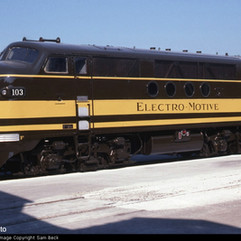Top Three Most Powerful EMD Diesel Locomotives
- bjlarosa96
- May 10, 2023
- 2 min read
Since I presented the Medals of Horsepower to the top three most powerful diesel locomotives from ALCO and Baldwin-Lima-Hamilton, let’s go back to Electro-Motive and discuss its top three models.
First up, the Gold Medal of Horsepower goes to the EMD DDA40X. Built solely for the Union Pacific from 1969 to 1971, it is the world’s largest and most powerful diesel-electric locomotive. This giant has two 16-645E engines, each producing 3,300 hp. Since the 645 prime mover normally produces 3,000 hp at 16 cylinders, the DD40 could have been rated at 6,000 hp instead of 6,600. However, it would still deserve the gold medal for its physical size, measuring over 98 feet long with a pair of eight-wheel trucks. I already covered the DDA40X last year, so here’s a link below.
Next, the Silver Medal of Horsepower goes to EMD’s six-axle, AC-motored SD90MAC-H. Although rated at 600 horses less than the DD40, the SD90 is the builder’s largest locomotive powered by one engine, which is the four-cycle 16-265H. Produced between 1996 and 1999, this model technically came in two cab phases (SD90MAC-H and SD90MAC-H II) but both versions are, of course, rated at 6,000 hp.
Lastly, the Bronze Medal of Horsepower goes to the 1939-built FT A-B-B-A set number 103. Each individual unit had a single 16-567 engine producing 1,350 hp. While it could be split into two separate 2,700-hp A-B halves, No. 103 was intended to be operated as a massive 5,400-hp articulated diesel locomotive. Because both A units were facing away from each other, the entire demonstrator set was indeed bidirectional, so no turntable was required. Some railroads did buy FT’s as four-unit A-B-B-A sets, but others preferred two-unit A-B sets. More specifically, some FT A-B sets would be later mated with subsequent locomotives such as F2A’s and F3A’s to form three-unit A-B-A sets. Although it may lose a few points for having two A units and two cabless booster units, No. 103 was an early attempt at maximizing horsepower by using the electrical multiple-unit cabling system, which allowed the three trailing covered wagons to be controlled by one operator on board the leading locomotive.









